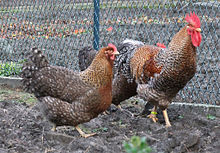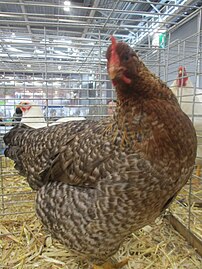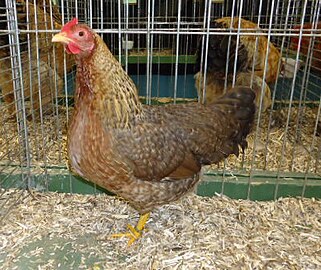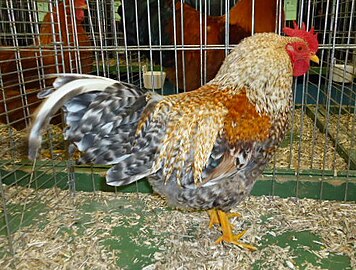|
Bielefelder Kennhuhn
The Bielefelder Kennhuhn (German pronunciation: [ˈbiːləfɛldɐ ˈkɛnˌhuːn]) or Bielefelder is a German breed of domestic chicken. It was developed in the area of Bielefeld in the 1970s by Gerd Roth, who cross-bred birds of Malines and Welsumer stock with American Barred Rocks to create the breed.[4][9]: 95 [10]: 6 Like other breeds with Barred Rock parentage, it is auto-sexing – chicks of different sexes can be distinguished by their colour. There is a bantam version, the Bielefelder Zwerg-Kennhuhn.[5] HistoryThe concept of an auto-sexing chicken breed goes back to the work of Reginald Punnett in the 1920s and 1930s.[10]: 6 The Bielefelder Kennhuhn was developed in the 1970s in the area of Bielefeld, in Ostwestfalen-Lippe in the state of Nordrhein-Westfalen.[4] It was created by Gerd Roth by cross-breeding of birds of Malines and Welsumer stock with American Barred Rock birds.[4][9]: 95 [10]: 6 It was first exhibited in 1976 as the Deutsche Kennhuhn; in 1980, when the breed was recognised by the Bund Deutscher Rassegeflügelzüchter, the name was changed to Bielefelder Kennhuhn.[10]: 6 In 2007 its conservation status, as reported to the DAD-IS database of the FAO, was "not at risk".[1]: 51 It is not among the endangered chicken breeds listed by the Gesellschaft zur Erhaltung alter und gefährdeter Haustierrassen.[11] CharacteristicsThe Bielefelder was initially bred in one colour only, crele (German kennsperber) – the cuckoo pattern with black-breasted red colouring. A silver variety (German silber-kennsperber) was later created; it shows the same patterning as in the crele variety, but without any red or yellow colouration. It is a new colour, not seen in any other breed.[10]: 7 Like other breeds with Barred Rock parentage, the Bielefelder is an auto-sexing breed – chicks of different sexes can be distinguished by their colour.[10]: 6 UseThe Bielefelder is dual-purpose breed, well suited to extensive management. It is fast-growing and yields a good carcass.[9]: 96 Hens may give about 230 large brown eggs per year, with an average weight of about 60 g.[4] Bantam hens may give about 160 eggs per year, with an average weight of 49 g.[5]
ReferencesWikimedia Commons has media related to Bielefelder Kennhuhn.
|
||||||||||||||||||||||||
Portal di Ensiklopedia Dunia




